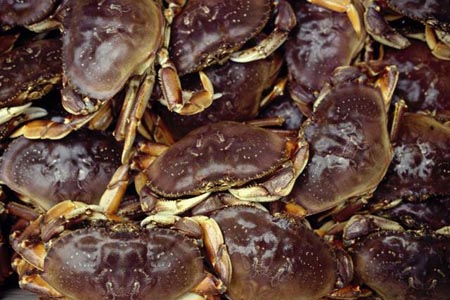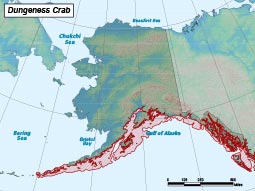Dungeness Crab
(Metacarcinus magister)
Species Profile
Did You Know?
Female Dungeness crab in Alaskan waters starve themselves during the six or more months during which they carry eggs. Perhaps because of this extended starvation period, Dungeness in Alaska produce eggs only every other year.
General Description
The Dungeness crab, Cancer magister/ syn. Metacarcinus magister, inhabits bays, estuaries, and the nearshore coast of Alaska. The species is named after one of its representative habitats––a shallow, sandy bay inside of Dungeness Spit on the south shore of the Straits of Juan de Fuca. It is widely distributed, and can be found as far north as the Aleutian Islands and as far south as Magdalena Bay, Mexico. This crab supports commercial personal use and sport fisheries in Alaska. The Dungeness crab is a decapod, related to shrimp, lobster, and other crab. It has a broad, oval body covered by a hard chitinous shell, four pairs of walking legs and a pair of claws. This species can be distinguished from other commercially important crab (king and Tanner crab) because its legs are much smaller and shorter in relation to its body size and because the dorsal surface of its carapace is smooth and spineless.
Size and Sex Determination
The legal measurement for Dungeness crab in Alaska is shoulder width, measured across the back of the carapace between the two notches immediately anterior to the tenth anterolateral spine, also known as "notch to notch". Only male Dungeness crab may be taken and sex can be determined from the shape of the crab’s abdomen. Females have a slightly rounded abdomen while males have a triangle-shaped abdomen. This becomes very pronounced when females mature into their egg-bearing developmental stage but is slightly less obvious for younger stages. The legal size for Dungeness crab in Alaska is 6.5 inches notch to notch.
Similar Species
There are eight congeners (same genus) to the Dungeness crab. Several of these, the European edible crab, Cancer pagurus, Jonah crab, Cancer borealis, and Atlantic rock crab, Cancer irroratus, are commercially harvested. The red rock crab, Cancer productus, is harvested by sport fishermen in Oregon.
Life History
Growth and Reproduction
Dungeness crab mate from spring through fall. Males are polygamous––each male crab may mate with more than one female. This may be an important factor in maintaining the reproductive viability of this species because only male crab can be harvested. Male crab only mate with female crab that have just molted (shed their old exoskeleton). Fertilization of eggs occurs about a month after mating when the female’s shell has hardened; until this time, the female crab stores the sperm in internal pouches especially designed for this purpose. Females can store sperm for as long as 2 years and old, large females will often use stored sperm to fertilize their eggs rather than molting and mating. The female extrudes eggs through pores on her ventral surface; they are fertilized as they pass through the stored sperm and adhere to hairs on the abdominal appendages where they are carried until hatching. A large female Dungeness crab can carry 2.5 million eggs.
After hatching, crab zoea larvae are planktonic and swim away freely. Larval development takes from 4 months to as long as a year in Alaska. Six successive larval stages (5 zoea and 1 megalopa) occur before the crab molts into the first juvenile stage. Crabs grow each time they molt. During the first two years both sexes grow at similar rates, but after two years males grow more quickly than females. Sexual maturity may be reached at three years. The legal size of 6.5 inches in shell width can be reached at four to five years of age, at which time the crab will weigh between 2 and 3 pounds. A large male Dungeness crab can exceed 10 inches in shell width. The estimated maximum life span is from 8 to 13 years.
Dungeness crab are widely distributed subtidally and prefer a sandy or muddy bottom in marine waters. However, they are tolerant of salinity changes and can be found in estuarine environments. They are most abundant in waters shallower than 30 meters, but have been found as deep as 200 meters.
Feeding Ecology
Dungeness crab foraging behavior coincides with their habitat. These crab scavenge along the sea floor for organisms that live partly or completely buried in the sand. They are both scavengers and predators, and their diet can include bivalves, worms, shrimp, fish, and small crab.
Range and Habitat
Dungeness crab are distributed from the Aleutian Islands to Magdalena Bay, Mexico.
Status, Trends, and Threats
Status
Commercial fisheries for Dungeness crab are currently prosecuted in waters offshore Kodiak Island and in Southeast Alaska.
Trends
Historical harvest of Dungeness crab in Alaskan waters peaked at 15.79 million pounds in 1982. The long-term average harvest for 1966–2011calendar years is 6.48 million pounds, and the 40, 30, 20, and 10-year averages are 6.47, 6.98, 5.49, and 5.31 million pounds respectively.
Threats
The primary threats to this species include predation by sea otters, ocean acidification, habitat damage (from activities such as log transfer facilities and intertidal development), and overfishing.
Fast Facts
-
Size
A legal-sized male Dungeness crab is 6 ½ inches in carapace width (shoulder width) and weighs approximately 2 pounds. -
Range
Dungeness crab are distributed from the Aleutian Islands to Magdalena Bay, Mexico. -
Diet
Dungeness crabs actively prey on small clams, worms, shrimp, and fish, but will also scavenge dead fish and invertebrates. -
Predators
Species which prey upon hard-shelled Dungeness crab include humans, sea otter, octopus and Pacific halibut; larger Dungeness crabs and staghorn sculpin are important predators on juvenile Dungeness crabs in some areas. In the soft-shell state, they are preyed upon by many additional species. -
Reproduction
Although Dungeness crabs are annual spawners throughout most of their range, females produce eggs biennially in Southeast Alaska. Mating between a hard-shelled male and a soft-shelled female occurs in late summer and sperm are stored internally in the female's 'spermathecae'. Egg masses are extruded from October through December and eggs are fertilized when they pass through the sperm mass as they exit through the genital pore. Egg clutch size increases with female size up to a maximum of about 2.5 million eggs. Eggs attach to specialized hairs on the females abdominal appendages and the female broods them while buried in the sediment in a quiescent state from December through June. Females do not eat during this period and consequently experience high post-hatching mortality. -
Fisheries
Dungeness crabs are caught commercially with pots or ring nets, and by subsistence, personal use, and sport fishermen with pots, ring nets, or snares.


